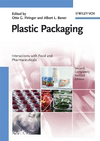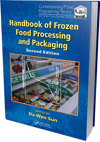 |
| Only 1.5 grams of plastic wrap is needed to keep a cucumber fresh for 14 days. |
The European Commission estimates that every year, up to 90 million tons of food is wasted in Europe and about a third of the food for human consumption is wasted globally – approx. 1.3 billion tons.
Food is wasted throughout the whole food chain, from farmers to consumers. One of the startling facts of food waste is that the amount of food lost or wasted every year is equivalent to more than half of the world’s annual cereals crop, according to the Food and Agriculture Organization of the United Nations.
In the context of the “European Roadmap to a Resource-Efficient Society,” tackling the problem of waste and food disposal depends on optimal packaging, responsible consumers’ behavior as well as proper waste management systems. Quite recently, the European Parliament called for the European Commission’s attention to the problem of waste disposal, aiming to decrease by half the food-waste being landfilled.
In fact, it has been proven that as the use of packaging materials increases, the fraction of food loss decreases by nearly 50 percent. Just to name a few examples, vacuum-packed produce prolongs shelf-life of food up to 5 times; milk box’s aseptic plastic lining prevents spoilage and a simple light plastics film provides a barrier against contamination and extends shelf life. Plastics packaging thus offers great environmental and societal benefits.
In developing countries, food loss ranges up to 50 percent in getting produce from farm to market due to the lack appropriate handling, transport and packaging solutions. In Europe, where packaging is used in handling, transporting, containing, storing and distributing foodstuffs, food loss in comparison ranges only at approximately 2-3 percent.
According to the study “The impact of plastic packaging on life cycle energy consumption and greenhouse gas emission in Europe” carried out by the Austrian sustainability consultancy, denkstatt, the average shelf-life of fresh food increases at least by 10 percent when fresh food is protected by plastic packaging compared to alternative materials. Today, plastics are increasingly substituting traditional materials due to their safety, light weight and superior functionality.
The beneficial impact of plastics packaging was clearly demonstrated by a British retailer who decided to switch from modified atmosphere packaging (MAP) to skin packs for meat packages and thereby increasing shelf-life from 5 to 10 days. This not only saves 33 pounds of CO2 but, 15,000 liters of water required in producing each 2.2 pounds of beef. Same goes for fresh vegetables, an unwrapped cucumber would last approximately 3 days while a shrink wrapped cucumber using 1.5 grams of plastics, will last up to 14 days. The use of plastics in packaging is not only linked to a better resource efficiency society but is in itself a sustainable resource. Contrary to popular belief, plastics packaging is enhanced by its low environmental impact. Though plastics packaging utilizes fossil fuels, this does not mean that it contributes to the exhaustion of this resource. In fact, the global plastics production relies only on 4 percent of the world oil and gas production.
The denkstatt study notes as well that the carbon footprint of plastics packaging amounts to a mere 1.7 percent per capita. The results were staggering. If other materials were to replace plastics packaging in the EU, Switzerland and Norway, life cycle energy demand would increase by a factor of 2.2 (by 1240 million gigajoules per annum), enough energy to heat some 20 million homes.
We all need to understand that plastics are too valuable to waste. Plastics’ properties provide many benefits to society during their use phase. There are also increasing options to continue to derive value from plastics at its end-of-life either via reuse, recycling or generating energy from waste.
In this regard, PlasticsEurope launched its initiative for “Zero Plastics to Landfill by 2020” to increase understanding and acknowledge the necessity to dispose of plastics, and other high calorific materials, in a responsible manner in order to capture the full value of this resource.
The acknowledgment of the resources we have and the use we give to them implies an environmentally sustainable attitude and the use of plastics in packaging has a lot to do with it. In this regards, the change of consumers’ behavior is a consequence of conveyance through the 4Rs of sustainable resource use:
R for REDUCE – Plastic packaging reduces energy use and CO2 emissions by providing efficient packaging, limiting the bulk of waste in landfills and the wastage of merchandise. Additionally, the amount of plastic necessary to manufacture highly-efficient packaging is increasingly being reduced by technological advances in plastics engineering. Ten years ago, the average plastic packaging weight was 28 percent higher than today and even more for some applications.
R for REUSE – Plastic packaging, especially plastic bags, containers and packs are easily re-used in simple, obvious ways. The exceptionally long life and durable quality of plastic packaging means that the material can be re-used again and again.
R for RECYCLE – When plastics packaging can no longer be reused, it can be recycled. Mechanical recycling involves the re-processing of end-of-life plastics into re-usable material through a mechanical process. Another exciting opportunity for the future is the development of an effective method to recycle plastic waste that involves converting the hydrocarbon chain into shorter units which can then be re-built into new polymers. Initially developed after the 1970s oil crisis, the key success factor will involve achieving high yield and selectivity in polymer conversion to produce the right raw material. Higher oil prices currently render feedstock recycling much more attractive.
R for RECOVER– Energy recovery involves recovering the energy contained in waste plastics. This process can either be accomplished in energy from waste plants (EfW) or in industrial production plants as a substitute for virgin fossil fuels.
We believe a 5th R for research and innovation should also be included, as new technologies are constantly being developed to ensure the maximum efficiency of the product.
Biodegradable plastics are an example of the constant development of the plastics industry and are ideally suited for applications where they will end their life in an industrial composting facility.
Compostable plastics bring added-value to specific products in terms of their end-of-life management. Examples involve composting of both food and its packaging compostable waste bags for the separate collection of organic wastes, compostable catering products (cutlery cups and plates). Compostable plastics are degradable due to a biological process occurring during composting and are converted into carbon dioxide, water, mineral salts and biomass.
Today, the packaging sector represents a 600 billion euro global industry. Plastic is the most important material in the flexible packaging market with over 70 percent market share in Europe and North America. Despite the recent economic downturn, the plastic industry is pushing forward persistently on research and development. In Europe, packaging applications are the largest application sector for the plastics industry and represent 39.4 percent of the total plastics demand.
PlasticsEurope



